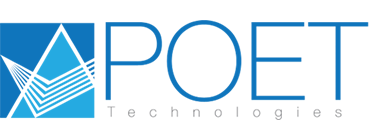POET Technologies Provides Update on 100-nm Initiative, Process Equipment Upgrade, and Technology Design Kits
May 27th, 2014
Toronto, ON, and Storrs, CT, May 27, 2014 – POET Technologies Inc. (TSX-V: PTK; OTCQX: POETF) (“the Company”) – developer of the planar opto-electronic technology (POET) platform for monolithic fabrication of integrated circuit devices containing both electronic and optical elements on a single semiconductor wafer – today announced a progress update on the 100-nm initiative, on the upgrade of its molecular beam epitaxy (MBE) system and on the technology design kit for the Planar Electronic Technology (PET) subset of the POET process.
100-nm Initiative
This milestone (M-8) is associated with reducing the feature size of key POET devices to the 100-nm range in scale. We had previously achieved sub-200-nm scaling as announced in the first quarter. While work progresses to drive down feature size further, our technical team now believes that it will achieve this milestone in the near-term.
Among the technical challenges addressed by the team are short-channel effects and the development and implementation of a novel technique based on using a non-gold based contact, without liftoff, to achieve selfalignment. This results in a general digital device format for III-V technologies. Many of these processes have been captured as new intellectual property for the Company by submission of patent applications.
Mr. Peter Copetti, Executive Chairman and interim CEO, noted, “The team has worked relentlessly through multiple hurdles on its way to completion of the 100-nm milestone. The scale-down to sub-100-nm scale will demonstrate our ability to fabricate competitive digital devices with III-V materials to a point that has never been demonstrated before.”
The technical team has targeted the end of the second quarter 2014 for completion of this milestone.
Upgraded Molecular Beam Epitaxy (MBE)
The MBE system is a key piece of process equipment on the POET pilot line. Earlier this year, the Company announced that there was a requirement for the MBE system to be taken off-line for maintenance, as well as for source material replenishment and a major upgrade. In anticipation of this, we had used the MBE to produce all material required for the 100-nm initiative, ahead of the scheduled outage.
As anticipated, the upgrade work required a total of two months of off-line work. This scheduled work is now completed, and the MBE system is back in service, growing wafers for use in further POET device work.
Dr. Geoff Taylor, Chief Scientist of the Company, noted, “With the old MBE system, we had demonstrated the short wavelength optical capabilities of our process, mainly for datacenter applications. With our newlyupgraded MBE system, our capabilities have expanded to fabricating optical devices with long wavelengths. This is critical for our POET offerings in the long-haul, networking and optical equipment market.”
PET Technology Design Kit (TDK)
This PET/TDK milestone (MS-12) focuses on devices requiring only the electronic subset of the POET process; PET offers lower cost and simpler process fab options for applications that do not require the full POET optical feature set. The PET/TDK allows the Company to deliver its technology to fab partners and customers, and enable further innovation to integrate both analog and digital functions together – an
application that is not possible today using silicon CMOS.
The PET/TDK milestone is progressing well, and as planned. As noted previously, the addition of Daniel DeSimone to the team has allowed this activity to remain on track, while other activities progress in parallel.
Moving PET/TDK forward requires optimizing our process technologies and devices using computer-aided design (TCAD) simulation. Specific TCAD efforts focus on complementary hetero-structure field-effect transistors (HFETs) and bipolar transistors (HBTs). This design basis will support complementary HFET (CHFET), bi-CHFET, bipolar and thyristor device fabrication.
CMOS technologies, both existing today and on the industry roadmap. PET/TDK models will be available to third parties around the end of the third quarter 2014.
Mr. Copetti noted, “Thanks are due to Dr. Taylor and the entire technical team for their dedication and relentless focus on the multiple milestones the Company has set for them.”
He added, “While timelines have had to accommodate challenges in our drive to 100-nm, I am encouraged by the significant recent progress, especially in parallel with our PET/TDK achievements. Our potential partners and customers have noted this significant progress, and this has allowed me and my executive team to have very detailed discussions with them under non-disclosure agreements, many of them ongoing at this time.”
By enabling increased speed, density, reliability, power efficiency, and much lower bill-of-materials and assembly costs, the POET semiconductor platform is expected to provide disruptive performance with an industry-compatible transition framework, and positions the Company as a leader in the new generation of
companies defining the growth paradigm in the post-Moore’s Law world.
About POET Technologies Inc.
POET Technologies is the developer of the POET platform for monolithic fabrication of integrated circuit devices containing both electronic and optical elements on a single semiconductor wafer. With head office in Toronto, Ontario, Canada, and operations in Storrs, CT, the Company, through ODIS Inc., a U.S. company, designs III-V semiconductor devices for military, industrial and commercial applications, including infrared sensor arrays and ultra-low-power random access memory. The Company has several issued and pending patents for the POET process, with potential high speed and power-efficient applications in devices such as servers, tablet computers and smartphones. The Company’s common shares trade on the TSX Venture Exchange under the symbol “PTK” and on the OTCQX under the symbol “POETF”. For more information please visit our websites at www.poet-technologies.com.
< Back to News
